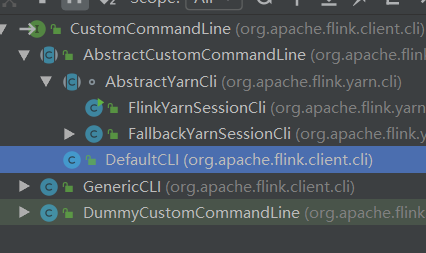【Flink提交流程源码】一、客户端任务提交源码CliFrontend找路径、配置、执行
一、Flink内核解析,针对版本1.12.0,四大块:任务的提交流程,组件通信,任务的调度,内存管理。
任务的提交流程:以命令行的提交命令开始追踪类,20多个步骤,几十个类,数千行代码量,最后画一个PPT动图
组件通信:actor的模型,akka基本原理和实现,5大关键角色:代理转发,处理细节,PPT动图
任务调度:streamGraph-jobGraph-ext,四个图的讲解,在什么步骤还是生成图,调用位置,如何转换,
task任务调度:调度器,调度模型,调度策略
task执行:以map算子为例,详细展示
内存管理:1.10之后的内存模型做了改进,jobmanage,taskmanage,
如何jvm内存不足的处理,内存的分配过程,数据结构,特有的组件,网络传输的内存管理如何实现
反压过程的讲解
二、yarn-per-job的提交流程讲解,企业常用的模式
前提启动hadoop,安装了flink,不需要启动flink集群
nc -lk 9999启动端口 flink run -t yarn-per-job /opt/module/flink-1.11.3/examples/streaming/SocketWindowWordCount.jar --port 9999
启动完成之后会多出这几个类
2466 NodeManager 4596 YarnTaskExecutorRunner 4426 YarnJobClusterEntrypoint 2124 DataNode 4749 Jps 1983 NameNode 3679 CliFrontend
执行客户端的入口类
org.apache.flink.client.cli.CliFrontend
进入main方法看主要逻辑,123,细枝末节太多,看主要逻辑,不然容易混乱
// 1. find the configuration directory
// 拿路径 final String configurationDirectory = getConfigurationDirectoryFromEnv(); // 2. load the global configuration
// 拿配置 final Configuration configuration = GlobalConfiguration.loadConfiguration(configurationDirectory); // 3. load the custom command lines
// 加载自定义命令行 三种顺序:1.generic,2.yarn,3.default final List<CustomCommandLine> customCommandLines = loadCustomCommandLines( configuration, configurationDirectory); try { final CliFrontend cli = new CliFrontend( configuration, customCommandLines); SecurityUtils.install(new SecurityConfiguration(cli.configuration));
// 核心逻辑run方法 int retCode = SecurityUtils.getInstalledContext() .runSecured(() -> cli.parseAndRun(args)); System.exit(retCode); }
进入cli.parseAndRun(args));
run -t yarn-per-job /opt/module/flink-1.11.3/examples/streaming/SocketWindowWordCount.jar --port 9999
// get action 这个拿到命令行参数的第一个,run
String action = args[0];
// remove action from parameters 除开run 后面的参数
final String[] params = Arrays.copyOfRange(args, 1, args.length);
switch (action) {
case ACTION_RUN:
//进入
run(params);
return 0;
case ACTION_RUN_APPLICATION:
runApplication(params);
return 0;
case ACTION_LIST:
list(params);
return 0;
case ACTION_INFO:
info(params);
return 0;
case ACTION_CANCEL:
cancel(params);
return 0;
case ACTION_STOP:
stop(params);
return 0;
case ACTION_SAVEPOINT:
savepoint(params);
return 0;
case "-h":
case "--help":
CliFrontendParser.printHelp(customCommandLines);
return 0;
case "-v":
case "--version":
String version = EnvironmentInformation.getVersion();
String commitID = EnvironmentInformation.getRevisionInformation().commitId;
System.out.print("Version: " + version);
System.out.println(commitID.equals(EnvironmentInformation.UNKNOWN) ? "" : ", Commit ID: " + commitID);
return 0;
default:
System.out.printf("\"%s\" is not a valid action.\n", action);
System.out.println();
System.out.println("Valid actions are \"run\", \"list\", \"info\", \"savepoint\", \"stop\", or \"cancel\".");
System.out.println();
System.out.println("Specify the version option (-v or --version) to print Flink version.");
System.out.println();
System.out.println("Specify the help option (-h or --help) to get help on the command.");
return 1;
}
进入 run(params);
//默认配置
final Options commandOptions = CliFrontendParser.getRunCommandOptions();
//获取命令行 final CommandLine commandLine = getCommandLine(commandOptions, args, true); // evaluate help flag if (commandLine.hasOption(HELP_OPTION.getOpt())) { CliFrontendParser.printHelpForRun(customCommandLines); return; } // 按顺序判断提交模式是否活跃 generic、yarn、default final CustomCommandLine activeCommandLine = validateAndGetActiveCommandLine(checkNotNull(commandLine)); final ProgramOptions programOptions = ProgramOptions.create(commandLine); //获取jar包 final List<URL> jobJars = getJobJarAndDependencies(programOptions); //有效配置:jobmanage,taskmanage的内存,slot槽数 final Configuration effectiveConfiguration = getEffectiveConfiguration( activeCommandLine, commandLine, programOptions, jobJars); LOG.debug("Effective executor configuration: {}", effectiveConfiguration); //打包 final PackagedProgram program = getPackagedProgram(programOptions, effectiveConfiguration); try {
//执行 executeProgram(effectiveConfiguration, program); }

这个就是最终执行:
executeProgram(effectiveConfiguration, program);
具体实现
final ClassLoader userCodeClassLoader = program.getUserCodeClassLoader();
final ClassLoader contextClassLoader = Thread.currentThread().getContextClassLoader();
try {
Thread.currentThread().setContextClassLoader(userCodeClassLoader);
LOG.info("Starting program (detached: {})", !configuration.getBoolean(DeploymentOptions.ATTACHED));
//执行环境信息
ContextEnvironment.setAsContext(
executorServiceLoader,
configuration,
userCodeClassLoader,
enforceSingleJobExecution,
suppressSysout);
StreamContextEnvironment.setAsContext(
executorServiceLoader,
configuration,
userCodeClassLoader,
enforceSingleJobExecution,
suppressSysout);
try {
program.invokeInteractiveModeForExecution();
}






 浙公网安备 33010602011771号
浙公网安备 33010602011771号